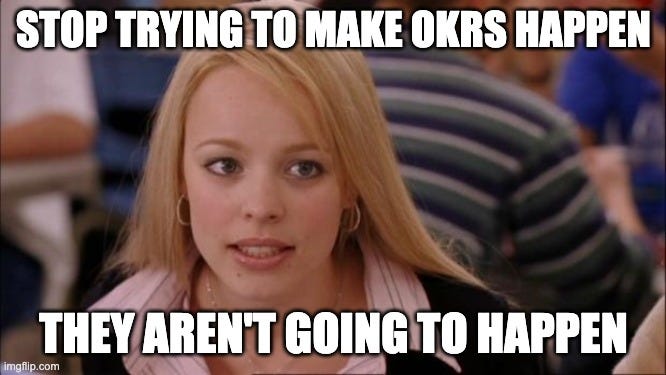The startup-friendly alternatives to OKRs
OKRs don't work for pre-PMF startups. Here are two other frameworks that are a better fit early stage projects.
Hello there! Welcome to my eclectic newsletter. My name is Ev, and I blog about technology and product, with a dash of strategy and a pinch of trends.
In today’s issue: OKRs, the nemesis of product teams in early stage startups.
OKRs and pre-Product Market Fit startups don’t mix. They also don’t work for 0-to-1 initiatives in big companies. To understand why, let’s start with a bit of history.
The genesis of OKRs is in Peter Drucker’s framework called Management by Objectives. The idea behind MBO is simple: teams must define goals they need to hit, and then create roadmaps for reaching them. It sounds reasonable, at least if the goals are deterministic, but in reality they are not.
Unlike MBOs, OKRs are more specific as they introduce measurable Key Results into the planning equation and — at least in theory — that helps teams to align on what really matters in the business. Unfortunately, in 0-to-1 products, “what matters” evolves faster than OKRs can accommodate.
Objectives and Key results is an idealistic framework that makes two assumptions:
First, it assumes that your company or group has a working strategy,
Second, it assumes that enough time (a.k.a. funding) is available to nail the OKR planning process and see tangible results.
Both of these assumptions are true for established revenue-generating products and are false for pre-Product Market Fit initiatives.
OKRs require a defined strategy
If you work in a startup environment and build 0-to-1 products, you must make snap decisions and pivot rapidly, or you will run out of funding. In fact, the primary existential objective of every pre-Product Market Fit startup is unlocking a repeatable strategy. According to Andrew Chen of a16z:
“OKRs are almost certainly harmful for pre-P/M fit startups because it causes teams to optimize towards goals as opposed to constantly asking if the goal is even the right one to begin with” [Source]
OKRs need time to master
The industry rule of thumb is that a team must go through several OKR planning cycles to get the process right. Taken at face value, this makes sense. But let’s put a timeline on this: OKRs are usually done quarterly, and if we assume it takes 3-4 cycles to get OKRs right, we’re looking at whole year spent to adopt a management process. A process that takes one year to master is simply wasteful.
OKR alternatives
Luckily, there are two alternatives to OKRs that are simpler to implement in early stage teams:
Narrative, Commitments, Tasks
Impact Maps
#1 NCTs: Narrative, Commitments, Tasks
Hands down one the most effective frameworks, NCTs allow pre-Product/Market Fit teams to manage uncertainty effectively.
NCTs address the most common complaint about OKRs which is objectives and key results that are disconnected from the direction of the company. NCTs solve this by forcing the team to articulate the greater “why” and thus align with the overall strategy explicitly.
The 3-step process for crafting NCTs is simple:
First, create a narrative that aligns with the larger business strategy
Second, define commitments a.k.a. measurable progress milestones that the team needs to achieve within a time frame (usually a quarter)
Third, define specific product development tasks that will help to achieve commitments
NCTs avoid another OKR pitfall: the Key Results theater when teams try to come up with ways to measure future success without understanding of the current customer or business goals.
Benefits: NCTs are suitable for both tactical planning on the team / group level, and for more strategic goal setting at the department level.
Downsides: NCTs are not as well-known in the industry, and if your leadership is hard-bent on OKRs, they might be a tough sell.
Read more about NCTs on Reforge: Trouble Hitting Your Goals? Here’s Why, and How to Make a Shift.
#2 Impact Maps
Impact Mapping is my go-to framework for quick planning. It was initially proposed by the brilliant Agile methodologist Gojko Adzic. Compared to NCTs, Impact Maps are more tactical, and they work best at an initiative level rather than product level. Nevertheless, Impact Maps can be extremely helpful if a team needs a lightweight approach to plan and evaluate the business upside of their work.

Impact Maps explicitly define the user, a.k.a. actor, whose activities help the business to hit goals. This feature contextualizes said goals and make them feel more tangible, which in turn allows to make planning with Impact Maps more focused.
Benefits: Impact Maps are intuitive and most teams can create them with little to no prior training.
Downsides: Impact Mapping helps define ways to achieve goals, but the framework will not help you question whether your goals are correct.
Want to work with me?
I work with founders and early-stage product development teams at Seed and Series A startups.
Let's talk if you need help accelerating your product execution and the search for PMF, setting up product discovery, and building a product team.
🚀 My calendar is open: https://calendly.com/evgeny-lazarenko/founder-product-coaching
Alternatively, you can hit me up on LinkedIn.

